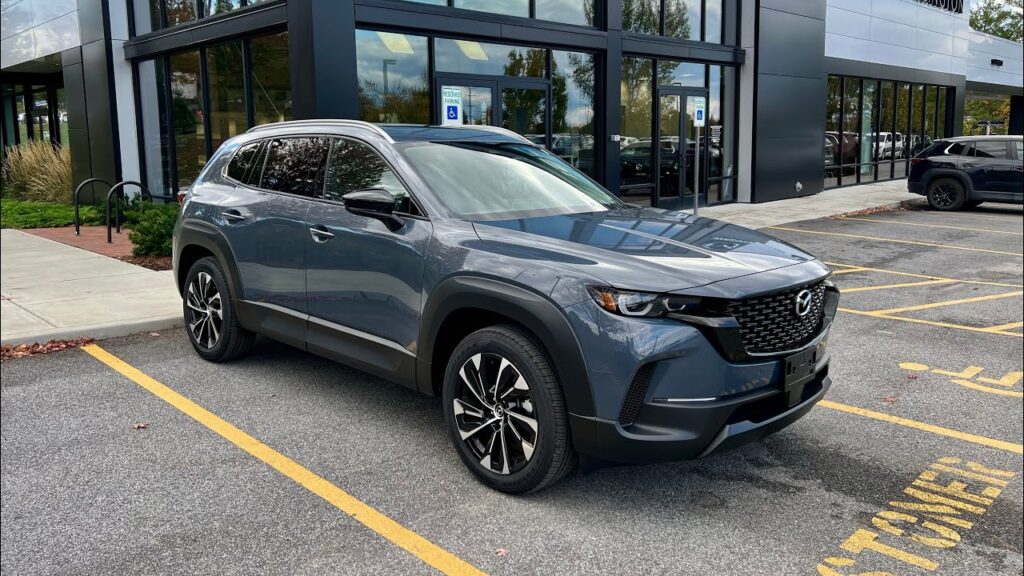What’s going on, readers? The Mazda crossover lineup has seen substantial evolution recently, and a key player in this shift is the Mazda CX-50. Since its introduction, it’s aimed to inject Mazda’s signature driving dynamics into the rugged compact SUV category. But as the competition heats up, especially against perennial favorites like the Toyota RAV4 and Honda CR-V, Mazda knows it can’t rest on its laurels.
Today, we’re diving deep into the latest model: the 2026 Mazda CX-50. This isn’t just a mild refresh; this version introduces noteworthy revisions that go beyond simple visual tweaks. The big question is: do these updates make enough of a difference to propel the CX-50 past its established rivals and onto the top of your shopping list?
Let’s find out exactly what the 2026 model offers, from its new trim structures and exterior styling to the heart-pounding performance of the turbo engine, the updated interior, and, crucially, how it stacks up against the competitive compact SUV landscape.
Performance and Powertrain: The Turbo Advantage of the CX-50
In a segment where high-horsepower options are becoming increasingly rare, the 2026 Mazda CX-50 holds a significant card: a powerful turbocharged engine option. Unlike many competitors that are moving exclusively toward hybrids or naturally aspirated setups, Mazda remains committed to offering a compelling performance choice.
Engine Options and Specifications
The 2026 CX-50 continues to offer three available powertrains, all paired with standard all-wheel drive (AWD)—a crucial differentiator against rivals that often charge extra for AWD or offer front-wheel drive (FWD) as standard.
- Standard 2.5L Four-Cylinder: Produces approximately 190 horsepower. This is the entry point, balancing adequate power with efficiency.
- 2.5L Turbocharged Four-Cylinder: This powerhouse, which we’re focusing on, delivers a potent 256 horsepower and an impressive 320 lb-ft of torque (when using 93 octane fuel). This torque figure is the real story, providing exhilarating off-the-line acceleration that few rivals can match. This engine is coupled with a smooth-shifting six-speed automatic transmission, which, despite being a more traditional choice than the Continuously Variable Transmissions (CVTs) found in most competitors, offers a more engaging and responsive feel.
- Hybrid Powertrain: Utilizing a system similar to the previous generation Toyota RAV4 hybrid, this variant delivers a combined 219 horsepower and focuses heavily on fuel economy. This option utilizes an ECVT (Electronic Continuously Variable Transmission).
The addition of a new, more accessible base turbo trim level for 2026 is a game-changer. Previously, getting the turbo meant stepping up to the Premium or Premium Plus tiers. Now, shoppers focused purely on performance can access the powerful engine at a lower price point, starting at an attractive $37,800 (plus destination), making the acceleration and torque advantage available to a wider audience.
Fuel Economy and Towing CUpdates
The penalty for choosing the powerful turbo is surprisingly small: the standard 2.5L rates 26 MPG combined, while the turbo rates 25 MPG combined. This minimal one MPG difference makes the turbo’s performance upgrade a fantastic value. For the efficiency-minded, the Hybrid rates a robust 38 MPG combined, showcasing a huge discrepancy and proving its worth at the pump.
Towing capacity is another area where the turbo shines, with a maximum rating of 3,500 lbs, significantly higher than the base 2.5L’s 2,000 lbs and the Hybrid’s 1,500 lbs. This capability reinforces the CX-50’s rugged, adventure-ready positioning.
Exterior Styling and 2026 Visual UTrade-Off
The CX-50’s exterior is already defined by its handsome, elongated profile and muscular cladding, but the 2026 model introduces subtle, yet effective, updates to sharpen its look and differentiate the top trims.
Trim Level Adjustments and New Aesthetics
Mazda has refined the trim structure to offer buyers more flexibility:
- The rugged Meridian trim is now available with both the standard gas engine and the turbo, expanding its appeal.
- The Premium Plus is now offered with the base engine, allowing non-turbo buyers access to more luxury features.
- The new base turbo trim lowers the entry barrier for performance.
Visually, the most notable change is the new gloss black badging on all turbo models. This blackout treatment applies to the Mazda logo, the CX-50, and the ‘Turbo’ designation, offering a cohesive, premium, and sporty look that continues onto the alloy wheels. This is a small detail, but it effectively distinguishes the higher-powered variants from the rest of the line.
Standard across the lineup are full LED headlights, with top-spec models (all Turbos and the top Hybrid) receiving adaptive LEDs for better night visibility. The overall design features a long vehicle length of 185.8 inches, blacked-out window surrounds, and standard roof rails, maintaining its sleek yet off-road-capable stance. The availability of intriguing paint colors, such as a deep blue and a unique green option, further emphasizes the CX-50’s desire to stand out.
Driving Dynamics: The Soul of a Mazda
If you’re cross-shopping the CX-50 with a Toyota RAV4 or a Honda CR-V, the difference in driving feel is immediately apparent. Mazda consistently prioritizes a sporty, engaging driving experience, and the CX-50 is no exception.
Handling and Ride Quality
The CX-50 is a fun-to-drive crossover. The steering is firm and highly responsive, providing excellent feedback and body control, especially when taking corners aggressively. This makes everyday driving more enjoyable and gives the vehicle a much tighter feel than the segment average. The powerful torque, especially from the turbo engine, facilitates dynamic acceleration, pushing you back into the seat and making even regular take-offs feel powerful.
However, this focus on sportiness comes with a trade-off in ride comfort. The suspension is definitely on the firmer side, meaning you will feel more bumps and road imperfections transmitted into the cabin compared to the softer, more family-focused rides of the Honda CR-V or even the larger Hyundai Palisade (which is known for a softer, more isolated ride). This is a core part of Mazda’s DNA—a sportier, driver-centric experience—but buyers seeking the ultimate plush ride should take note.
Noise Levels and Safety Features
Our sound level reading at 55 mph came in at 58.2 dB. While this places the CX-50 solidly in the middle of the pack for the compact SUV segment, it is not the quietest vehicle tested. It offers a good balance, but it doesn’t quite achieve the near-silent cabin experience of some premium-leaning rivals.
In terms of safety, the CX-50 excels by offering a comprehensive suite of standard active safety features across all trim levels. This includes crucial technology like adaptive cruise control. The only notable exception is rear auto braking, which is reserved for the top-end models.
Interior Updates, Technology, and Luxury Touches
The interior of the CX-50 maintains Mazda’s reputation for offering a premium, near-luxury cabin experience that often punches above its weight class.
Premium Materials and Cabin Design
Materials quality is a highlight. The cabin features soft-touch plastics, premium leatherette on armrests, and, on upper trims, genuine leather with intricate cross-stitching details across the dashboard and center tunnel. New for 2026 is a striking new white interior color option, adding to the existing premium choices like the terracotta interior and the hybrid’s red option. The overall fit and finish is excellent, feeling solid and well-engineered.
New Standard and Expanded Features for 2026
Mazda has significantly upped the ante on standard equipment for 2026, making upper-tier features more accessible:
- Standard Wireless Charger: Now included on all trims.
- Expanded Heated/Ventilated Seats: Previously limited ventilated seats are now available on more trim levels (Premium and above). Crucially, the formerly excluded top-end hybrid now gains access to the heated steering wheel and the heated rear seats, rectifying a bizarre omission from previous years.
- Standard Panoramic Sunroof: This is a massive feature. The panoramic sunroof is now standard on every trim level except the absolute base model. This is a standout feature in the segment, where most competitors make you pay a significant upcharge for this expansive glass roof even on their most expensive trims.
- Head-Up Display (HUD): Standard on all turbo models, a feature usually reserved for only the very top trims of rivals.
Infotainment and Practicality: A Mixed Bag
The standard 10.25-inch display is crisp and clear. Crucially, wireless Apple CarPlay and Android Auto are standard and allow for touchscreen functionality. However, Mazda’s proprietary navigation and native menus must be controlled via the console-mounted commander knob. While Mazda argues this reduces driver distraction, it can feel counter-intuitive compared to the fully touch-enabled systems of rivals.
In terms of practicality, the CX-50 falls slightly short of its most spacious rivals. The center console storage, while present, is not cavernous. Rear-seat comfort is decent but firm, and while legroom is good at approximately 40 inches, it is less than what you’ll find in a Honda CR-V, and the rear seats offer no recline function, a common feature in this segment. While premium rear features like Type-C charging ports and available heated seats are present, the cabin ultimately prioritizes style and driver focus over maximum utility.
Cargo Capacity and the Utility Trade-Off

The CX-50’s sleek profile and sporty dimensions come at a cost to ultimate utility when compared to boxier competitors. Its cargo capacity figures are respectable but noticeably less than the segment leaders:
- Behind Second Row: Approximately 31 cubic feet
- Maximum (Seats Folded): Approximately 56 cubic feet
For comparison, both the newest Toyota RAV4 and the Honda CR-V offer between 15 and 20 cubic feet more maximum cargo space. This is a key area where shoppers must decide if the CX-50’s superior driving dynamics and premium interior are worth the trade-off in sheer carrying capacity. The good news is that the rear seats fold easily with convenient release handles in the cargo area, and the space is still highly usable, with cargo length measuring around 41 inches behind the second row.
Pricing, Resale Value, and the Final Verdict
2026 Pricing Structure
The starting price for the 2026 Mazda CX-50 is just over $29,000, representing a minimal price increase over the previous year and keeping it highly competitive. Impressively, prices for some high-end examples have actually been reduced. The fully loaded Turbo Premium Plus starts just under $43,000, making it a compelling luxury alternative.
The new base turbo trim, priced around $37,800, offers arguably the best value proposition in the lineup, delivering 256 horsepower for thousands less than what was previously required.
Resale and Reliability Data
Mazda has steadily improved its reputation for both reliability and retaining value:
- Resale Value: After 5 years and 60,000 miles, the CX-50 is estimated to retain 59.44% of its original MSRP. This is an excellent figure, placing Mazda’s resale value right behind only industry giants like Subaru, Toyota, and Honda.
- Reliability: Mazda’s overall brand reliability is rated slightly above the industry average, according to combined studies. This offers buyers peace of mind, backed by a standard warranty of 3 years/36,000 miles basic and 5 years/60,000 miles powertrain.
The CX-50 vs. the Competition
The 2026 Mazda CX-50 is not trying to be a Toyota RAV4 or a Honda CR-V. Those rivals win on ultimate practicality, maximum rear-seat space, and hybrid fuel efficiency. However, the CX-50 offers something neither of them can match: a truly engaging driving experience, a powerful and accessible turbo engine, and an interior that feels genuinely premium.
The 2026 updates, particularly the standard panoramic sunroof and the more affordable base turbo trim, address key areas and bolster the CX-50’s position. If you value a sporty drive, high-end materials, and impressive performance in your compact SUV, the 2026 Mazda CX-50 should unquestionably be a priority. It’s the compact SUV for the buyer who secretly wishes they were driving something a little more exciting.






